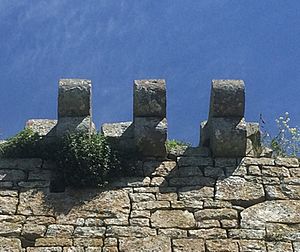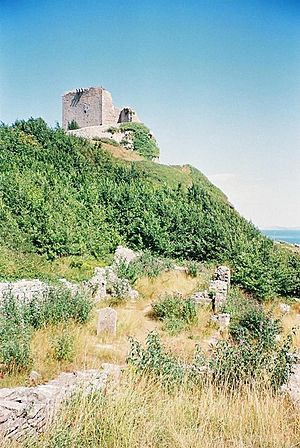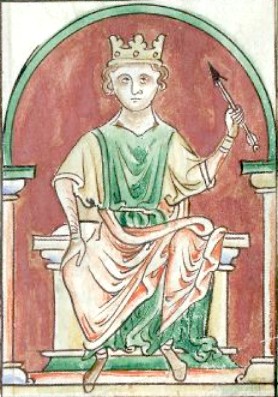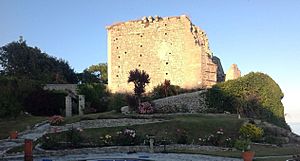Rufus Castle facts for kids
Rufus Castle, also known as Bow and Arrow Castle, is an old castle that is partly in ruins. It stands on the Isle of Portland in England, looking over Church Ope Cove. The castle gets its name from King William II, who was also called William Rufus. The first castle was built for him.
Most of the castle you see today was built in the late 1400s. This makes it the oldest castle on Portland. It was built on a tall rock, but some parts have fallen away over time because of erosion. The castle was likely the main tower, or keep, of a larger fort. It had a five-sided tower with special openings for guns from the late Middle Ages. The castle also has an older base that might be from the 1100s. Today, you can still see parts of the main tower, sections of walls with gun openings, and a bridge built in the 1800s.
Rufus Castle and its bridge are very important historic buildings. They have been officially protected since 1951 as a Grade I listed building. It is one of only three buildings on Portland with this high level of protection. The castle is also a scheduled monument, which means it's an important archaeological site.
From Rufus Castle, you can see the Shambles sandbank, about 3 miles (5 km) out at sea. This was a very dangerous spot for ships. In 1805, a ship called the Earl of Abergavenny sank there, and 263 people died. The ship's captain, John Wordsworth, was the brother of the famous poet William Wordsworth. The poet wrote a poem about this sad event. Later, in 1653, the Battle of Portland happened beyond the Shambles. The English navy, led by Robert Blake, fought against the Dutch Navy.
Rufus Castle is privately owned, so you can't go inside. However, you can get a great view of it from public walking paths along the coast.
Contents
History of Rufus Castle
Long ago, people on Portland raised money to build the island's first castle for defense. Rufus Castle is said to have been built for King William II. However, the ruins we see today are not from that exact time. In 1142, Robert, Earl of Gloucester, took the castle from King Stephen. He did this to support Empress Maud. Later, in 1238, Richard de Clare added more defenses to the castle.
The castle was rebuilt between 1432 and 1460 by Richard, Duke of York. Most of what is left today comes from this rebuilding. In the late 1700s, a writer and politician named John Penn built a large house called Pennsylvania Castle nearby. This new estate included Rufus Castle. Penn changed Rufus Castle to make it look more like a beautiful ruin. He built a bridge and created new openings in the castle walls. In 1989, one of the castle's arches facing the sea collapsed. Later, English Heritage suggested restoring the castle to protect it.
Rufus Castle in Books and Art
Rufus Castle has appeared in many works of art and literature. The famous English artist J. M. W. Turner sketched the castle. He even drew the arch twice in one of his rare changes. The castle also appeared as 'Red King's Castle' in Thomas Hardy's novel, The Well-Beloved. Hardy's name for the castle came from King William II, who was also known as William the Red. This part of the Portland coast was also featured in the early chapters of Victor Hugo's novel The Man Who Laughs. More recently, the castle was the home of a fictional character in Gerald Seymour's thriller, The Dealer and the Dead.
Restoring Rufus Castle
From 2010 to 2012, a lot of work was done to restore and strengthen Rufus Castle. This work was supported by English Heritage. The castle had been listed on the Heritage at Risk Register in 2010, meaning it needed urgent repairs.
Work started in 2010 with architect Russ Palmer. With help from English Heritage, the first step was to check the castle's condition. Then, they began the needed repairs, especially on the north walls. The work cost £150,000 and was finished by November 2010. It included strengthening the top of the walls and filling gaps in the stone.
How Rufus Castle Was Built
The castle has a unique five-sided shape. Its walls facing the land are about 7 feet (2.1 meters) thick. These walls have many medieval gun ports, which are often mistaken for arrow loops. These openings are why the castle is also called "Bow and Arrow" Castle. The castle is built from Portland stone, with rough, squared stones forming its walls. Rufus Castle does not have a roof today. Three of its sides are much longer than the others.

On the north and west walls, on the first floor, there are five openings with round gunports. These walls also have groups of three stone corbels. These corbels once held up a stone parapet that stuck out from the wall. Outside the south entrance, you can see the remains of stone foundations. There are no longer any traces of the "steps of stone" that once connected the castle to the old St Andrew's church.
Images for kids
See also
 In Spanish: Castillo de Rufus para niños
In Spanish: Castillo de Rufus para niños







